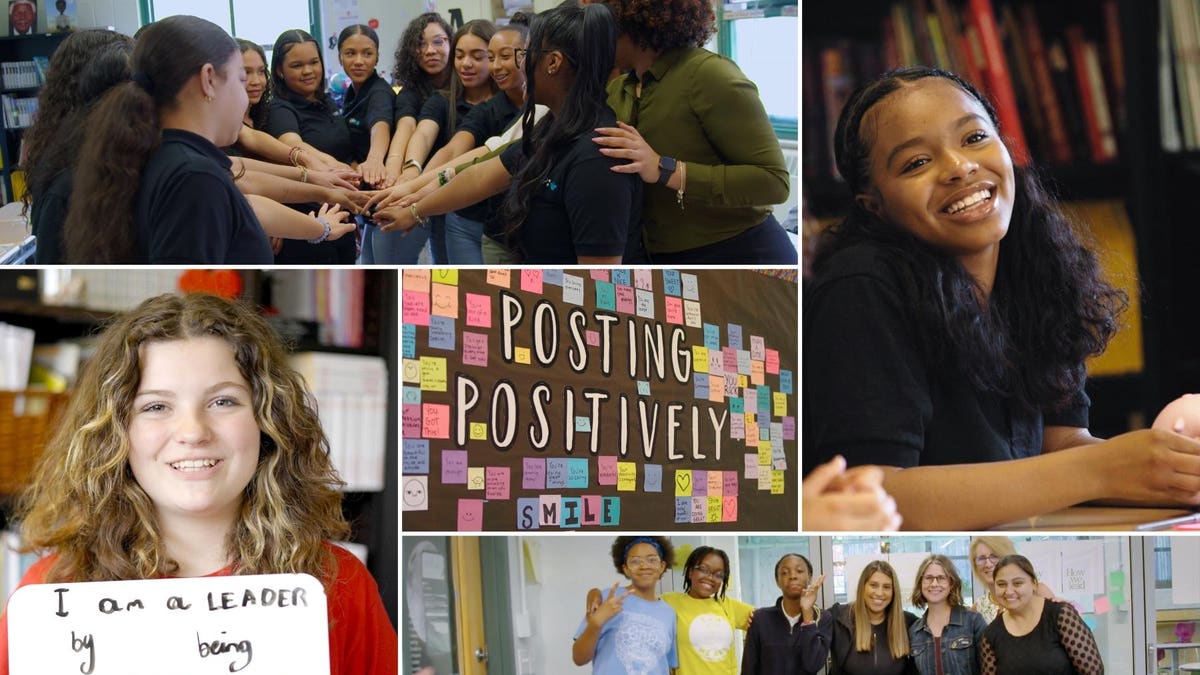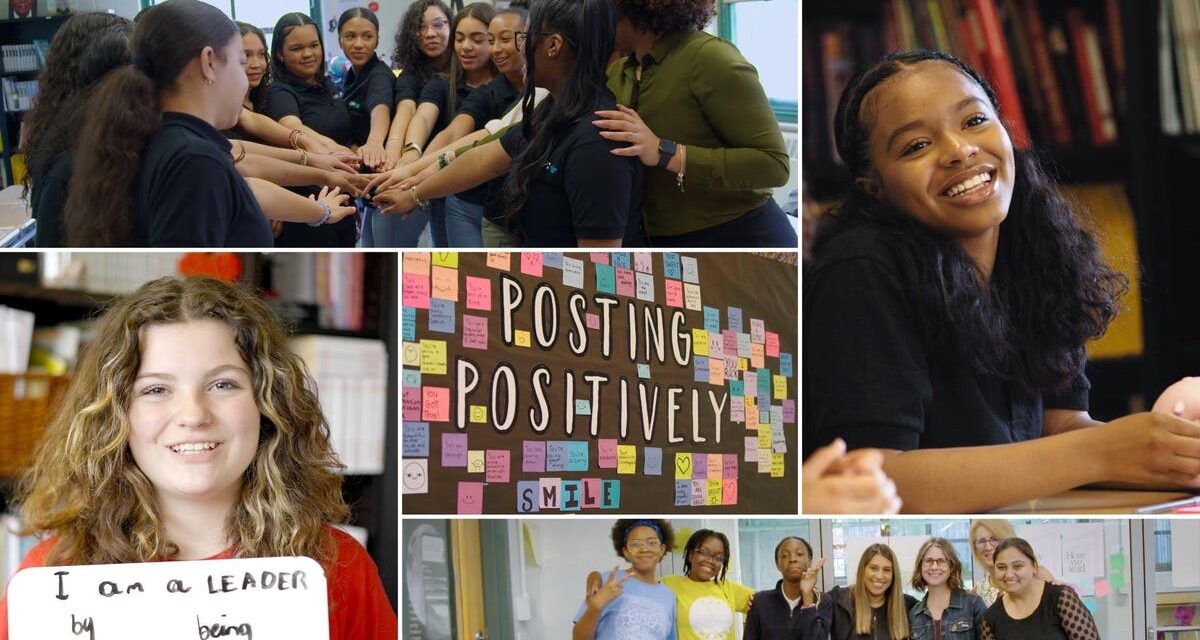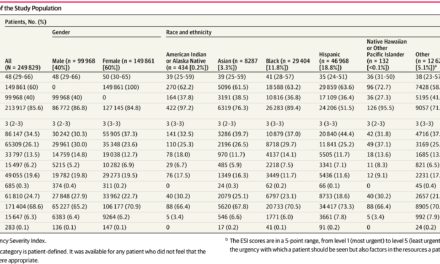
With statistics showing that nearly 50% of girls think speaking their mind will make them unlikable and only 1 in 5 girls ages 8-17 think they have the qualities to be a good leader, it’s no wonder that there is a glaring inequity of women in leadership positions across all levels and industries today. In addition to the structural obstacles and external barriers that can hold women back from advancing as leaders, they often also face their own sense of personal limitations and internal glass ceilings that can prevent them from even seeing themselves as leaders in the first place. And these perceived limitations so often begin in girlhood, as girls internalize the cultural biases, discouraging messages, and constrictive stereotypes that come at them from various aspects of the media and all corners of society.
This is the very reason that Lean In—the organization founded in 2013 by Sheryl Sandberg and Rachel Thomas whose mission is to help women achieve their ambitions and work to create an equal world—developed Lean In Girls, which launches today, July 27. Lean In Girls is a leadership program and curriculum that aims to help girls and non-binary teens who identify with the girlhood experience, ages 11-15, see themselves as leaders in a world that often tells them they’re not, equip them to be self-assured, resilient and inclusive everyday leaders, and inspire them to lead boldly.
Sandberg explains, “We’ve been working for a really long time to help women get into leadership roles, both encouraging them that they can do it, to not internalize the biases they face where they are systematically underestimated, but also to make sure that other people don’t have those biases. So we really want to do the same thing Lean In’s been doing for a long time. We are explicitly for female leadership. We are unapologetically for a world where more women are leading and is a more inclusive leadership for women, particularly and especially for women of color. And what we realized is, we have to bring that message much younger because oftentimes by the time women get into the workforce, they’ve already faced so much systematic bias that the idea of leadership feels daunting. So we need to start encouraging girls in leadership at younger ages.”
“It’s tough to be a girl,” says Thomas, the CEO of Lean In. “We know that teenage girls are struggling. We know girls still face a lot of biases that unfairly hold them back. As a culture, we still more strongly associate boys and men with leadership than we do women and girls. We know that girls are still inadvertently told to quiet down or to not assert themselves.” She adds, “There’s still a likability penalty for women and girls that comes with being bold, loud and opinionated, and we need to blow that up. We know our culture signals to girls that how they look is more important than what they think, and that is so undermining to girls and their self-esteem.”
Lean In Girls addresses these issues through a free curriculum rooted in ethnographic and social science research and developed in collaboration with a braintrust of experts in gender studies, leadership, childhood development and diversity, equity and inclusion. In addition to these experts, they worked with a panel of girls and nonbinary teens who identify with the girlhood experience to help develop lessons that are fun, engaging and create authentic opportunities for participants to share and connect.
“The thing I’m so proud of in this program is that, like everything we do at Lean In, we are deeply research-based,” says Sandberg. “We took years worth of research to understand what’s going on, and what we realized is that we need a different definition of leadership and we need to talk about leadership differently in two ways. The first is, we don’t want to discourage our girls and tell them at really young ages that they’re going to face bias, so often we don’t. But it turns out that the research is showing that that real talk earlier—‘Hey, this isn’t going to be easy for you,’ ‘Hey, the world treats girls and boys on leadership differently’—benefits them. They appreciate it, they learn from it, and it gives them what they need to really see it differently.”
“The second thing,” Sandberg continued, “is that we need a really inclusive definition of leadership that tells them that leadership has to be what they want it to be. The traditional definitions are very masculine and they reward aggression, command and control. But leadership can be collaborative and supportive. Leadership can be inclusive. And when they understand that, that’s the kind of leadership that resonates more with them. That leadership is the kind of leadership the world needs, and they can be a huge part of that.”
Thomas agreed, saying, “Girls prefer a definition of leadership that includes being collaborative, listening to and supporting others and improving society. And that’s exactly the leadership we need, regardless of gender. We know from research that when girls are introduced to a more expansive definition of leadership, they’re more likely to see themselves as leaders. When they know how to identify and push back against unfair treatment, they’re less likely to internalize negative and limiting messages and less likely to blame themselves when they experience bias. We know when girls take positive risks and learn new skills, they feel a really powerful sense of agency and accomplishment.”
The Lean In Girls program includes strength-building activities and real talk on important topics like bias and allyship. As Thomas put it, “Let’s get real with girls about what they’re up against. Let’s talk openly about stereotypes and bias and help them figure out how to navigate a world that’s often stacked against them. How do we lean into some of the softer or subtler strengths that girls often show, like friendship and collaboration, and celebrate that those are valuable leadership skills? How do parents continue to challenge gender norms in their houses? How do teachers challenge gender stereotypes in classrooms?”
Since every girl and every community is distinct, the Lean In Girls materials are adaptable and customizable so facilitators can tailor the content to best meet the needs of their group. “This is built to be really inclusive,” explains Thomas. “These teams are bringing lots of different identities to the experience, and we’re running the program in different parts of the country, so we made a major investment in how to make it responsive so facilitators can adjust it to their group and you can choose what you think is relevant for the teens in the room with you.”
“Leadership comes in many different ways, sizes and forms,” said Bianca, a facilitator at KIPP Washington Heights Middle School in New York, New York. “These girls are from all different walks of life, but at the end of the day, they come here and they get to see that, ‘I’m not angry, I’m passionate. I’m not loud, I’m just powerful.’ So we’re really shifting their own language about themselves.”
In addition to helping girls see themselves as leaders, the materials also offer advice and resources for the adults in girls’ lives, which Sandberg and Thomas hope will help society shift biases and remove obstacles in girls’ way. Thomas explains, “We want to equip girls to lead in their own unique way, and we want the world to clear a path for them to do that, and then celebrate leadership in all its forms, in all the ways that girls want to lead, whether that’s in a quiet collaborative style or a bold and assertive style—we want to embrace all of that.”
For example, offered Thomas, “One of our recommendations to parents, caregivers and teachers is, when a girl is nice or really thoughtful to a classmate, don’t say, ‘Oh, that was nice’ or ‘That was sweet.’ Say, ‘That’s actually a leadership trait, being empathetic, being caring.’ So we need to switch that definition. And if we do, there are so many more ways girls are leading every day than we often realize. So the first lesson in the curriculum is literally introducing a more expansive definition of leadership to girls and really saying, ‘You’re already leading, and there are lots of ways to lead.’”
The Lean In Girls curriculum is open to all caregivers and educators and can be taught by any caring adult who goes through the online facilitator training. And because they want to collaborate with facilitators and reach as many girls as possible, the materials will always be available at no cost. “Lean In has made it incredibly easy to be a part of Lean In Girls,” says Maggie, a facilitator at Marian Middle School in St. Louis, Missouri. “The types of resources they provide, the facilitation guides, the participant guides—everything is organized, it’s comprehensive and it’s in one space. It’s a great program for young middle school girls because it’s saying it’s okay to be unique because by being unique you’re going to be your own type of leader. It really is giving them the keys to their own future.”
Through Lean In, Sandberg and Thomas have been advancing women’s leadership for over ten years. Their hope is that Lean In Girls will multiply those efforts by fostering a new generation of women leaders, so we can get closer to gender equity and we can all benefit from the much-needed perspectives, talents and visions we know diversity brings. When asked why she is so passionate about helping more girls become leaders, Sandberg responded, “I really just so deeply believe that the world needs more leaders who are women and more leaders who are women of color.”
Thomas put it this way: “We need more women leaders; that’s never felt more clear to me. And we think girls are those leaders. The messages of this program are empowering and uplifting for girls and are going to give them the tools and the insights they need to navigate the road ahead, equipping girls to lead today and be resilient, inclusive and empathetic leaders. And then also hopefully inspiring them to lead in bigger, bolder ways and pursue their dreams as they get older. We think that has a real potential to change the world.”
For more information on Lean In Girls, visit leaningirls.org.




